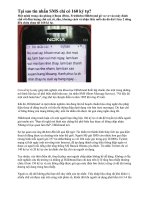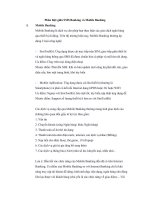AQA 74083BA SMS
Bạn đang xem bản rút gọn của tài liệu. Xem và tải ngay bản đầy đủ của tài liệu tại đây (258.7 KB, 12 trang )
A-level
PHYSICS
(7408/3BA)
Paper 3 – Section B (Astrophysics)
Mark scheme
MARK SCHEME – A-LEVEL PHYSICS PAPER 3 – ASTROPHYSICS - 7408/3BA – SPECIMEN
Mark schemes are prepared by the Lead Assessment Writer and considered, together with the relevant
questions, by a panel of subject teachers. This mark scheme includes any amendments made at the
standardisation events which all associates participate in and is the scheme which was used by them in
this examination. The standardisation process ensures that the mark scheme covers the students’
responses to questions and that every associate understands and applies it in the same correct way.
As preparation for standardisation each associate analyses a number of students’ scripts. Alternative
answers not already covered by the mark scheme are discussed and legislated for. If, after the
standardisation process, associates encounter unusual answers which have not been raised they are
required to refer these to the Lead Assessment Writer.
It must be stressed that a mark scheme is a working document, in many cases further developed and
expanded on the basis of students’ reactions to a particular paper. Assumptions about future mark
schemes on the basis of one year’s document should be avoided; whilst the guiding principles of
assessment remain constant, details will change, depending on the content of a particular examination
paper.
Further copies of this mark scheme are available from aqa.org.uk
2
MARK SCHEME – A-LEVEL PHYSICS PAPER 3 – ASTROPHYSICS - 7408/3BA – SPECIMEN
Physics - Mark scheme instructions to examiners
1. General
The mark scheme for each question shows:
•
•
•
•
the marks available for each part of the question
the total marks available for the question
the typical answer or answers which are expected
extra information to help the Examiner make his or her judgement and help to delineate what
is acceptable or not worthy of credit or, in discursive answers, to give an overview of the area
in which a mark or marks may be awarded.
The extra information is aligned to the appropriate answer in the left-hand part of the mark
scheme and should only be applied to that item in the mark scheme.
At the beginning of a part of a question a reminder may be given, for example: where
consequential marking needs to be considered in a calculation; or the answer may be on the
diagram or at a different place on the script.
In general the right-hand side of the mark scheme is there to provide those extra details which
confuse the main part of the mark scheme yet may be helpful in ensuring that marking is
straightforward and consistent.
2. Emboldening
2.1
In a list of acceptable answers where more than one mark is available ‘any two from’ is
used, with the number of marks emboldened. Each of the following bullet points is a
potential mark.
2.2
A bold and is used to indicate that both parts of the answer are required to award the
mark.
2.3
Alternative answers acceptable for a mark are indicated by the use of or. Different terms
in the mark scheme are shown by a / ; eg allow smooth / free movement.
3. Marking points
3.1 Marking of lists
This applies to questions requiring a set number of responses, but for which candidates
have provided extra responses. The general principle to be followed in such a situation is
that ‘right + wrong = wrong’.
Each error / contradiction negates each correct response. So, if the number of errors /
contradictions equals or exceeds the number of marks available for the question, no
marks can be awarded.
However, responses considered to be neutral (often prefaced by ‘Ignore’ in the mark
scheme) are not penalised.
3
MARK SCHEME – A-LEVEL PHYSICS PAPER 3 – ASTROPHYSICS - 7408/3BA – SPECIMEN
3.2
Marking procedure for calculations
Full marks can usually be given for a correct numerical answer without working shown
unless the question states ‘Show your working’. However, if a correct numerical answer
can be evaluated from incorrect physics then working will be required. The mark scheme
will indicate both this and the credit (if any) that can be allowed for the incorrect approach.
However, if the answer is incorrect, mark(s) can usually be gained by correct substitution /
working and this is shown in the ‘extra information’ column or by each stage of a longer
calculation.
A calculation must be followed through to answer in decimal form. An answer in surd form
is never acceptable for the final (evaluation) mark in a calculation and will therefore
generally be denied one mark.
3.3
Interpretation of ‘it’
Answers using the word ‘it’ should be given credit only if it is clear that the ‘it’ refers to the
correct subject.
3.4
Errors carried forward, consequential marking and arithmetic errors
Allowances for errors carried forward are likely to be restricted to calculation questions
and should be shown by the abbreviation ECF or conseq in the marking scheme.
An arithmetic error should be penalised for one mark only unless otherwise amplified in
the marking scheme. Arithmetic errors may arise from a slip in a calculation or from an
incorrect transfer of a numerical value from data given in a question.
3.5
Phonetic spelling
The phonetic spelling of correct scientific terminology should be credited (eg fizix) unless
there is a possible confusion (eg defraction/refraction) with another technical term.
3.6
Brackets
(…..) are used to indicate information which is not essential for the mark to be awarded
but is included to help the examiner identify the sense of the answer required.
3.7
Ignore / Insufficient / Do not allow
‘Ignore’ or ‘insufficient’ is used when the information given is irrelevant to the question or
not enough to gain the marking point. Any further correct amplification could gain the
marking point.
‘Do not allow’ means that this is a wrong answer which, even if the correct answer is
given, will still mean that the mark is not awarded.
3.8
Significant figure penalties
An A-level paper may contain up to 2 marks (1 mark for AS) that are contingent on the
candidate quoting the final answer in a calculation to a specified number of significant
figures (sf). This will generally be assessed to be the number of sf of the datum with the
least number of sf from which the answer is determined. The mark scheme will give the
range of sf that are acceptable but this will normally be the sf of the datum (or this sf -1).
3.9
Unit penalties
An A-level paper may contain up to 2 marks (1 mark for AS) that are contingent on the
candidate quoting the correct unit for the answer to a calculation. The need for a unit to
be quoted will be indicated in the question by the use of ‘State an appropriate SI unit for
4
MARK SCHEME – A-LEVEL PHYSICS PAPER 3 – ASTROPHYSICS - 7408/3BA – SPECIMEN
your answer ‘. Unit answers will be expected to appear in the most commonly agreed
form for the calculation concerned; strings of fundamental (base) units would not. For
example, 1 tesla and 1 weber/metre2 would both be acceptable units for magnetic flux
2 -2 -1
density but 1 kg m s A would not.
3.10 Level of response marking instructions.
Level of response mark schemes are broken down into three levels, each of which has a
descriptor. The descriptor for the level shows the average performance for the level.
There are two marks in each level.
Before you apply the mark scheme to a student’s answer read through the answer and
annotate it (as instructed) to show the qualities that are being looked for. You can then
apply the mark scheme.
Determining a level
Start at the lowest level of the mark scheme and use it as a ladder to see whether the
answer meets the descriptor for that level. The descriptor for the level indicates the
different qualities that might be seen in the student’s answer for that level. If it meets the
lowest level then go to the next one and decide if it meets this level, and so on, until you
have a match between the level descriptor and the answer. With practice and familiarity
you will find that for better answers you will be able to quickly skip through the lower
levels of the mark scheme.
When assigning a level you should look at the overall quality of the answer and not look to
pick holes in small and specific parts of the answer where the student has not performed
quite as well as the rest. If the answer covers different aspects of different levels of the
mark scheme you should use a best fit approach for defining the level and then use the
variability of the response to help decide the mark within the level. i.e. if the response is
predominantly level 2 with a small amount of level 3 material it would be placed in level 2.
The exemplar materials used during standardisation will help you to determine the
appropriate level. There will be an answer in the standardising materials which will
correspond with each level of the mark scheme. This answer will have been awarded a
mark by the Lead Examiner. You can compare the student’s answer with the example to
determine if it is the same standard, better or worse than the example. You can then use
this to allocate a mark for the answer based on the Lead Examiner’s mark on the
example.
You may well need to read back through the answer as you apply the mark scheme to
clarify points and assure yourself that the level and the mark are appropriate.
Indicative content in the mark scheme is provided as a guide for examiners. It is not
intended to be exhaustive and you must credit other valid points. Students do not have to
cover all of the points mentioned in the indicative content to reach the highest level of the
mark scheme
An answer which contains nothing of relevance to the question must be awarded no
marks.
5
MARK SCHEME – A-LEVEL PHYSICS PAPER 3 – ASTROPHYSICS - 7408/3BA – SPECIMEN
Question
01.1
Answers
Additional Comments/Guidance
Concave mirror with parallel incident rays reflecting to different
focal points.
PA does not need to be drawn.
Rays further from PA brought to focus nearer the mirror.
01.2
The mark scheme gives some guidance as to what
statements are expected to be seen in a 1 or 2 mark (L1), 3 or
4 mark (L2) and 5 or 6 mark (L3) answer. Guidance provided
in section 3.10 of the ‘Mark Scheme Instructions’ document
should be used to assist in marking this question.
Mark
Criteria
QoWC
6
All three aspects covered:
The student presents
relevant information
coherently, employing
structure, style and sp&g
to render meaning clear.
The text is legible
A full comparison of location
in terms of the affect of
atmosphere on the GTC, and
the difficulties of maintaining,
servicing and obtaining data
from IUE.
A quantitative comparison of
the collecting power with
conclusion that GTC has
530x collecting power of IUE.
A quantitative comparison of
minimum angular resolution,
with conclusion that GTC is
5x better.
Mark
1
1
The following statements are likely to be
present:
Location
•
light must travel through some of
the atmosphere to reach GTC
which affects the amount of light
arriving and resolution.
•
IUE In orbit needs its own power
source,
•
and information needs to be sent to
ground for analysis.
•
position of IUE inconvenient as, if
something goes wrong, it is difficult
to service an orbiting satellite.
Collecting power
•
Collecting power is proportional to
D2.
•
So ratio is 10.42/0.452 = 530
•
GTC has 530x collecting power.
6
MARK SCHEME – A-LEVEL PHYSICS PAPER 3 – ASTROPHYSICS - 7408/3BA – SPECIMEN
•
5
4
Two of the three aspects fully
covered, with some detail
missing from the third.
One aspect fully covered,
with some detail missing from
the other two
Or
Two aspects fully covered,
with little or no relevant
information about the third.
3
GTC better as bigger diameter
telescopes make brighter images.
Minimum angular resolution
The student presents
relevant information and
in a way which assists the
communication of
meaning. The text is
legible. Sp&g are
sufficiently accurate not to
obscure meaning.
•
Minimum angular resolution is
proportional to 1/D
•
θ= λ/D so ratio of min angular
resolution is (1 x 10-6/10.4) / (2 x
10-7 / 0.45) = 0.2
•
GTC is 5x better at resolving
•
GTC better as bigger diameter
telescopes make clearer images.
All three aspects partially
covered, with some detail
missing from each
Or
One aspect fully covered,
with little or no relevant
information about the other
two
2
Two aspects partially
covered, with little or no
relevant information about the
third.
1
One aspect partially covered,
with little or no relevant
The student presents
some relevant information
in a simple form. The text
is usually legible. Sp&g
allow meaning to be
derived although errors
are sometimes
7
MARK SCHEME – A-LEVEL PHYSICS PAPER 3 – ASTROPHYSICS - 7408/3BA – SPECIMEN
0
01.3
information about the other
two.
obstructive.
Little or no relevant
information about any of the
three aspects.
The student’s
presentation, spelling
punctuation and grammar
seriously obstruct
understanding.
1
QE. = no. of photons arriving at detector and being detected
total arriving at detector
For CCD QE> 80%
For eye QE = 1%
8
Both needed
1
MARK SCHEME – A-LEVEL PHYSICS PAPER 3 – ASTROPHYSICS - 7408/3BA – SPECIMEN
02.1
02.2
02.3
02.4
Spectral class A
1
The temperature range for A class is 7500 K to 11 000 K
1
Lowest value of apparent magnitude indicates the brightest
star.
1
Vega has the lowest apparent magnitude (so is brightest)
1
Closest of three stars is Altair
1
Using
m – M = 5 log (d/10)
To give
0.77 – 2.21 = - 1.44
And
d = 5.2 pc
Deneb is the largest
No mark for unsupported answer
It has approximately the same temperature, but has a much
brighter absolute magnitude and therefore greater power
ouput
Allow alternative:
As P = σAT4
Using
To give
1
1
To have a much greater power output for a similar
temperature, it must have a greater area
02.5
Allow ce for calculation of wrong star
from position on HR diagram, from T and M,
=3.8 x 10-7 m
1
Altair and Vega are main sequence stars
Deneb is a giant star
so Deneb largest.
λ max T = 0.0029
λ max = 0.0029/7700
1
1
1
1
9
MARK SCHEME – A-LEVEL PHYSICS PAPER 3 – ASTROPHYSICS - 7408/3BA – SPECIMEN
03.1
An object that produces a rapid increase in brightness
Allow lowering in value of absolute magnitude
1
03.2
Extremely dense
Ignore descriptions of Neutron star surface
1
Made up of neutrons
Ignore refs to spinning or producing radio
waves
03.3
1
Use of Rs = 2GM/c2
To give
Rs = 2 x 6.67x 10-11 x 2 x 2 x 1030/ (3 x 108)2
First mark is for substitution
1
Second mark for answer
1
Collapsing star can produce gamma ray bursts with energy
similar to total output of Sun
First mark is for gamma ray burst and an idea
of the amount of energy
1
Highly collimated – if in direction of Earth, could cause mass
extinction event
Second mark is for consequence.
3
= 5.9 x 10 m
03.4
10
1
MARK SCHEME – A-LEVEL PHYSICS PAPER 3 – ASTROPHYSICS - 7408/3BA – SPECIMEN
04.1
Star much brighter than reflected light from planet
1
Or
Planet very small and distant – subtends very small angle
compared to resolution of telescopes
04.2
Planet and star orbit around common centre of mass that
means the star to moves towards/away from Earth as planet
orbits
Causes shift in wavelength of light received from star
04.3
Light curve showing constant value with dip
When planet passes in front of star (as seen from Earth),
some of the light from star is absorbed and therefore the
amount of light reaching Earth reduced
Apparent magnitude is a measure of the amount of light
reaching Earth from the star
1
1
1
1
1
11
aqa.org.uk
Copyright © 2014 AQA and its licensors. All rights reserved.
AQA Education (AQA) is a registered charity (registered charity number 1073334) and a company limited by guarantee registered in
England and Wales (company number 3644723). Registered address: AQA, Devas Street, Manchester M15 6EX
8 October 2014









